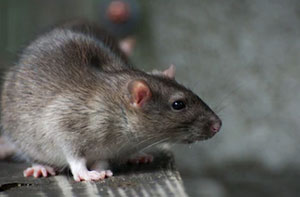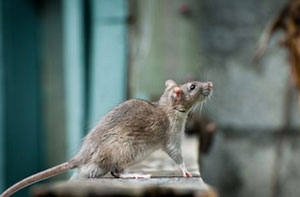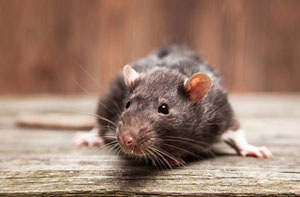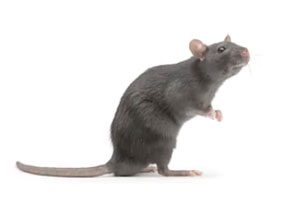Stanmore Rat Catchers (HA7): While it's not such a frequent occurrence nowadays in Stanmore, folks do still have issues with rats once in a while. Seeing rats in your home or garden is not a good experience, and is sufficient to cause some property owners nightmares. Lone rats aren't likely to create very much of a problem, although rats tend to reproduce rapidly and may start to cause issues when they grow in numbers.
If you do happen to see rats in Stanmore, the chances are that they're going to be brown rats, though there are actually 2 types of rat currently found in the United Kingdom; black (or ship) rats and brown (common) rats. As you could be aware ship rats were blamed for the Great Plague (17th C) and at that time they were extremely widespread. Black rats are quite rare now but in fact neither breed is native to the British Isles, both of them hailing from from Asia.

Brown rats are ordinarily larger than black rats (Rattus Rattus) and may weigh as much as half a kilogram, with a length of around 9 inches. Much of the damage and destruction attributable to brown rats is due to the fact that to keep their incisors from getting too long, they've got to continually chew on stuff. Woodwork is especially vulnerable to their attention.
Rats spread diseases, gnaw through wires, woodwork, insulation and pipes, leave droppings, and will generally cause a nuisance in businesses and homes in Stanmore. Property owners ought to report sightings of rats to their relevant local authorities. In addition you can report rat sightings on the .gov web page HERE.

You'll oftentimes be alerted to the existence of rats not in fact by seeing them, but by them indicating their activity in other ways. It could be that you could come across a rat's nest hidden away, you may hear noises coming from a loft, floor or wall, you may come across rat holes gnawed in skirtings or floorboards or you may start seeing droppings in cupboards or on floor surfaces.
In order to have this issue dealt with correctly you must speak to an expert. You could contact the local environmental health department or call in a specialist Stanmore pest controller or rat catcher for yourself. There are no longer a lot of folks nowadays who just specialize in issues with rats, you are also able to bring them in if you have a wasps nest in your loft or maybe moles digging up your lawn.
Rat catching and pest control can be undertaken in Stanmore and also in: Wealdstone, Broadfields Estate, Harrow Weald, Belmont, Headstone, Burnt Oak, Bushey Heath, Watford, Elstree, Bushey, Kenton, Edgeware, South Oxhey, Kingsbury, North Harrow, Pinner, Northwood, The Hale, Canons Park, Queensbury, and in these postcodes HA7 1AA, HA7 1JH, HA7 1FE, HA7 1GD, HA7 1BG, HA7 1LU, HA7 1HW, HA7 1DN, HA7 1DX, and HA3 8RR. Locally based Stanmore rat catchers will likely have the postcode HA7 and the dialling code 020.
Rat Sightings - Reporting
The following is a little more detail on a topic we brought up earlier in this article. The local authorities is the place to send a report should you witness rats in a public space, in a neighbours garden or in your own garden. With regards to rats this is quite often a cost-free service, even though you'll usually be asked to pay for other pests like bed bugs, wasps and cockroaches. You can check out the .gov webpage HERE to report sightings of rats. Click HERE to organize your local rat catcher and get the problem sorted promptly.
Rat Bite Wounds
Although, in Stanmore, bites from rats aren't that common, they certainly do occur on occasion, and the consequences can be serious in some scenarios. When cornered or scared, rats can attack and bite humans, therefore if you stumble upon one one in a confined area, it's best to leave an exit route so it can easily escape.
Rat bites have been known to occur in houses where rats are being kept as pets, and placing your hand into a rat's cage is certainly something to be avoided. Although rat bites are not dangerous in every case, they can become infected or be fatal if they turn into "rat bite fever" (caused by Streptobacillus moniliformis). If it is not treated appropriately "rat bite fever" (RBF) can cause death, and has has a 10% mortality rate.
Signs of Rat Bite Fever (RBF) - The signs and symptoms of "rat bite fever" (streptobacillary RBF) include:
- Vomiting
- Redness or Swelling
- Headaches
- Fever
- Muscle Pain
- Rashes
- Joint Pain
You should promptly wash the affected area with warm water, if you get bitten by a rat, then administer an antibiotic ointment to the bite area, and cover it with a clean, sterile plaster or bandage. You must head straight to your nearest A&E and get it checked out, even if you don't consider it to be that serious, or at the minimum arrange an appointment with your GP or doctor. If you have not had a tetanus vaccination in the last 5 years or so, it would be sensible to get one of these as well - A&E will almost certainly do this routinely.
Rat Prevention Stanmore
For maintaining the safety of your home and property from damage and health risks, rat prevention is essential. All food sources should be stored securely in airtight containers to begin with. Since rats are drawn to easy meals, it's essential to keep your kitchen clean and free of food scraps or crumbs. Keep pet food securely stored and empty bins on a regular basis.

Sealing entry points is another important step in rat prevention. Search your property for any cracks, gaps or holes that rats could use to gain access. Give special attention to areas around vents, doors and pipes. Use materials like steel wool or caulk to block these potential entry points, as rats may chew through many popular sealing materials.
Keeping a clean and tidy environment outside your property is also crucial for preventing rats. Keep your garden clear of junk, like piles of leaves or wood, where rats could nest. Ensure compost heaps are covered and cut back any overgrown vegetation. Collect any fallen fruit promptly if you've got fruit trees. By taking these simple steps, the risk of a rat infestation in and around your property or home in Stanmore can be dramatically reduced. (Rat Prevention Stanmore)
Ultrasonic Pest Control
To repel pests like rats, insects, mice, and other critters, ultrasonic pest control employs high-frequency sound waves. The technology works by emitting sound waves that are above the human hearing range but are audible to pests. These sound waves create an uncomfortable and disorienting environment for pests, making it difficult for them to navigate and communicate with each other.
Even though ultrasonic pest control units are easy to use and reasonably priced, their effectiveness is subject to dispute. The effectiveness of these devices is variable and subject to conflicting results in studies, with some showing successful pest repulsion while others indicating virtually no impact. The efficiency of ultrasonic pest control can fluctuate depending on factors such as the species of pest, the treated area's size, and environmental variables. Like any pest control strategy, it is crucial to consider all alternatives and consult with a specialist before deciding. While ultrasonic pest control can be effective, it is best used in combination with other pest control techniques for maximum effectiveness.... READ MORE.
Species of Rat
You're only going to encounter two sorts of rat in Stanmore, Greater London and throughout the United Kingdom. The Black Rat (Rattus Rattus) and the Brown Rat (Rattus Norvegicus).
The Brown Rat (Rattus Norvegicus)
The most common species of rat present in the British Isles, and also in Europe, is the brown rat (street rat, sewer rat, common rat or Norwegian Rat (Rattus Norvegicus)). The brown rat (it can sometimes be grey) is ordinarily 4-9" long (not including the tail) and weighs in at 140 - 500 grammes. It is always found wherever human beings are living. Though once considered to have spread from Norway (hence its name), it is now understood to have first come from China or at least Central Asia. Brown rats have bad eyesight but good hearing, they dig a lot and climb effectively, they are omnivores but prefer cereal grains, the females may reproduce 5 litters of as many as Fourteen per year.
The Black Rat
Originating in India and Southeast Asia the black rat, ship rat or roof rat is also not a native species of the British Isles or Europe. It's regarded as having spread throughout Europe at the time of the Roman Empire, probably traveling in cargoes of spice. The black rat was once common in Great Britain but was essentially replaced by the more dominant brown rat and is now fairly uncommon. Growing to a length of five to seven inches, the black rat weighs only 75 to 230 grams. Known to pass on listeria, toxoplasmosis, rat bite fever, trichinosis, typhus, Weil's disease, tularemia, salmonella and bubonic plague, black rats are notorious spreaders of pathogens and disease.
General Pest Control in Stanmore
Essential for the preservation of a pest-free environment and the protection of health and property is the practice of general pest control. It encompasses the management and prevention of everyday pests, including rats, flies, ants, spiders and cockroaches. Pest control measures that are known to help include regular inspections, maintaining cleanliness, sealing potential entry points, correct waste management, and using insecticides or traps when necessary. Eco-friendly and sustainable approaches take priority in IPM (Integrated Pest Management) techniques, aiming to minimise chemical usage. A healthier and safer working or living environment for themselves and those around them can be achieved by individuals in Stanmore through the implementation of extensive pest control strategies. These strategies don't just address existing pest issues but also act as a proactive defense against future infestations, ensuring long-term pest-free surroundings. (52599 - General Pest Control Stanmore)
In Conclusion
When you've got a rat problem in Stanmore you could be tempted to try to solve it on your own - and naturally lots of homeowners in Stanmore do choose that approach. Rat traps, rat poisons and similar merchandise is available in shops, supermarkets and hardware stores in the Stanmore area, so the stuff you need can easily be bought.

Calling in a competent Stanmore rat exterminator would however be preferable, unless of course you know exactly what you're doing, seeing as the right approach isn't always the obvious one.
The amateur use of rat poisons will likely cause more problems than it solves, because you must be extremely cautious with them when pets and children could possibly come into contact with them. If you know what is better for you, always use a professional rat control service in Stanmore for solving your rat problems. (Tags: Rat Control Stanmore, Rat Exterminator Stanmore, Rat Removal Stanmore)
Pest Control Services Stanmore
Stanmore rat catchers can normally help you with pest netting, rat catching, pest control for fleas in Stanmore, rat extermination in Stanmore, bird nest clearing, rat infestations, household pest control in Stanmore, pest control services, environmental pest control, pest control, rat prevention, rat baits, ingress pest solutions, fox pest control in Stanmore, rat control in Stanmore, restaurant pest control, wildlife management, the control of pests, bed bugs pest control, wasp nest removal, cockroach pest conrtol, squirrel control, rat trapping, fogging & spray treatments, residential pest control, powder treatments, ultrasonic pest control in Stanmore, emergency pest control, the removal of contaminated loft insulation, mouse control and other pest control in Stanmore. Listed are just a selection of the tasks that are handled by those installing pest control. Stanmore companies will let you know their full range of pest control services.
Other Pests in Stanmore: Also pest control help with hornets in Stanmore, bees in Stanmore, pigeons in Stanmore, cockroaches in Stanmore, mice in Stanmore, wasps in Stanmore, clothes moths in Stanmore, bedbugs in Stanmore, moles in Stanmore, fleas in Stanmore, silverfish in Stanmore, ants in Stanmore, carpet beetles in Stanmore, rabbits in Stanmore Greater London.
Pest Control Near Stanmore
Also find: Bushey rat catchers, Canons Park rat catchers, Queensbury rat catchers, Kingsbury rat catchers, Burnt Oak rat catchers, Elstree rat catchers, Edgeware rat catchers, North Harrow rat catchers, Broadfields Estate rat catchers, Pinner rat catchers, Bushey Heath rat catchers, Wealdstone rat catchers, Harrow Weald rat catchers, Headstone rat catchers, Kenton rat catchers, Belmont rat catchers, The Hale rat catchers, South Oxhey rat catchers, Watford rat catchers, Northwood rat catchers and more. These and other places are serviced by pest control specialists and similar experts. Ensuring effective and efficient rodent issue resolution, these versatile professional pest controllers bring a wealth of know-how and expertise. These pest control experts are equipped with the skills and tools required to swiftly deal with any situation, be it a solitary rat or a larger infestation. If you're a local home or property owner looking to obtain competitive and accurate pest control quotes tailored to your particular needs, just click here.
More: Rat Trapping, Rodent Control, Rat Specialists, Rat Elimination, Rat Specialists, Rat Removal, Rat Solutions, Rat Extermination, Rat Removal, Rat Specialists, Rat Control, Commercial Rat Control, Pest Control, Cheap Rat Catchers, Rodent Control, Rat Prevention, Mouse Control, Pest Control, Rat Catching, Rat Elimination, Rat Trapping, Commercial Rat Control, Rodent Control, Rat Extermination, Rat Catchers, Cheap Rat Removal, Pest Removal, Rat Catching, Rat Prevention, Rat Elimination, Cheap Pest Control, Pest Controllers, Domestic Pest Control, Woodworm Treatment, Pest Control Experts.
Rat Trapping Stanmore Stanmore - Mouse Control Stanmore - Rat Catchers Near Me - Pest Control Stanmore - Rat Exterminators Stanmore - Mouse and Rat Control Stanmore - Rat Pest Control Stanmore - Rat Catching Stanmore - Rat Control Stanmore




